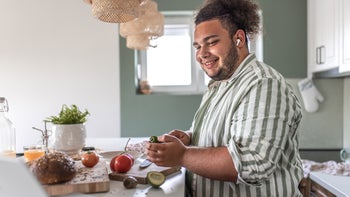
5 Foods to Avoid When Taking Ozempic
Key takeaways:
Ozempic (semaglutide) is an injectable prescription medication that’s FDA approved to treat diabetes. But it can cause side effects like nausea, vomiting, diarrhea, and constipation.
Some foods can worsen the side effects of Ozempic. Avoiding alcohol — and greasy, high-fat foods — can lower your chance of experiencing unwanted side effects.
Limiting ultra-processed and sugary foods can help Ozempic better control blood sugar.
Access savings on related medications
Table of contents
Ozempic (semaglutide) is an injectable medication that can help treat Type 2 diabetes. It can also lower the risk of serious cardiovascular events in people with diabetes and heart disease. Ozempic can cause unwanted side effects like nausea, vomiting, and diarrhea.
But there are ways to limit, or even avoid, these unpleasant side effects. Avoiding certain foods can help lower your risk of gut upset and improve your blood sugar control.
Let’s look at the best foods and drinks to eat and those to avoid while taking Ozempic
Get Lantus For Less
With GoodRx, pay no more than $35 for a 30 day supply of Lantus.

GoodRx is NOT insurance. GoodRx Health information and resources are reviewed by our editorial staff with medical and healthcare policy and pricing experience. See our editorial policy for more detail. We also provide access to services offered by GoodRx and our partners when we think these services might be useful to our visitors. We may receive compensation when a user decides to leverage these services, but making them available does not influence the medical content our editorial staff provides.
Foods to avoid while taking Ozempic
There’s no “Ozempic diet” or foods and drinks you absolutely can’t eat while taking Ozempic.
But Ozempic can cause stomach upset — and other gut side effects. So you may want to avoid foods that can worsen or trigger these symptoms.
You also want to avoid foods that can raise your blood sugar too quickly. This will help Ozempic and other diabetes medications better control insulin production and release.
Here are five foods and drinks to avoid when taking Ozempic.
1. Foods that are high in fat
Foods that are high in fat can worsen Ozempic side effects. On their own, these foods can lead to stomach upset. So, when they’re combined with Ozempic, the likelihood of developing gut side effects goes up.
Plus, since Ozempic slows how quickly the stomach empties, these foods have even more time to hang around and upset your gut.
How to manage Ozempic-induced nausea: It’s one of the most common side effects of Ozempic. Check out our expert tips for minimizing upset stomach while taking this medication.
What to expect when you take Ozempic: Hear from real people who have taken Ozempic and find out how they managed side effects from nausea to cravings.
Tips to balance your blood sugar: Try the diabetes plate method for a simple strategy that can help keep your blood sugar steady.
Examples of high-fat foods include:
Fried foods like french fries or fried chicken
Greasy foods like pizza, cheeseburgers, and donuts
High-fat dairy products like ice cream, butter, cream, and some cheeses
2. Sugary foods and drinks
If you have diabetes, you know how important it is to limit sugary foods and beverages. Foods with a high glycemic index make it harder to control blood sugar.
Read more like this
Explore these related articles, suggested for readers like you.
High-sugar foods to cut back on include:
Baked goods like cake and cookies
Candy
Soda
Juice and sweetened drinks
Some foods have a surprisingly high amount of added sugar. Make sure to check food labels so you don’t eat or drink something that has more sugar than you expected.
3. Ultra-processed carbohydrates
Carbohydrates are an important part of a healthy diet. But not all carbohydrates are good for you. Ultra-processed carbohydrates, or refined carbohydrates, lack fiber and most vitamins. And they can cause spikes in your blood sugar levels, which can make it harder for Ozempic to do its job.
Try to limit refined carbohydrates, like:
White bread
White flour
Crackers
4. Starchy vegetables
Vegetables are an important part of a healthy diet. But starchy vegetables have a high glycemic load, which can affect blood sugar levels.
You don’t have to ditch starchy vegetables completely. But try to limit how much of them you eat. This will help Ozempic work at its best. Some examples of vegetables with a higher glycemic load include:
Potatoes
Corn
Parsnips
Rutabaga
5. Alcohol
If you’re taking Ozempic, it’s a good idea to limit alcohol or avoid it altogether. Alcohol irritates the stomach. And Ozempic gives alcohol more time to linger in the stomach, increasing the chances of stomach upset and nausea.
Combining alcohol with diabetes medications, including Ozempic, also raises your risk of developing low blood sugar (hypoglycemia). Hypoglycemia can be dangerous to your health.

Foods to eat while taking Ozempic
Now that you know which foods to avoid while taking Ozempic, let’s look at some Ozempic-friendly foods. These foods can help you get the most out of your Ozempic treatment. And they can lower your chances of developing unpleasant Ozempic-related side effects.
First, choose foods and drinks that don’t quickly raise or lower blood sugar. This helps keep your blood sugar steady. And it lets Ozempic (and other diabetes medications) work to their best ability.
It’s also a good idea to stick to low-fat, non-greasy foods because these are less likely to irritate the gut.
Try adding the following foods to your daily diet.
Lean protein
Lean protein contains unsaturated, or healthy, fats. They’re also a great source of protein and other important nutrients. Your appetite will be lower while taking Ozempic. So it’s important to prioritize foods that are high in important nutrients like healthy fats, protein, and vitamins.
Examples of lean protein include:
Fish
Chicken
Turkey
Beans
Tofu
Low-fat dairy products
Like lean protein, dairy products contain proteins and vitamins. But you may want to opt for low-fat dairy products, because full-fat dairy may upset your stomach while taking Ozempic.
Examples of low-fat dairy products include:
Low-fat milk
Cottage cheese
Greek yogurt
Seeds and nuts
Seeds and nuts are another great source of healthy fats and minerals. They’re calorie dense, but you’ll be less likely to overeat while taking Ozempic. Seeds and nuts are also a great option if you’re looking for a plant-based source for these key nutrients.
Low-glycemic fruits and vegetables
Fruits and vegetables that have a low glycemic index are less likely to cause rapid changes in blood sugar levels. This can help Ozempic work better to control blood sugar.
Non-starchy vegetables include:
Leafy greens
Tomatoes
Radishes
Carrots
Low-glycemic fruits include:
Fresh berries
Apples
Citrus fruits
Other tips for avoiding Ozempic side effects
It’s not just what you eat that can trigger side effects from Ozempic: How you eat matters too.
Here are some other eating tips to help lower your chances of experiencing Ozempic side effects:
Take Ozempic before meals instead of after meals.
If you’re eating carbs, add in some protein. This can balance your blood sugar.
Avoid dairy and fat in the evenings, since this can lower the chances of overnight nausea, heartburn, and belching from Ozempic.
Eat slowly, as this can help prevent stomach upset from slowed emptying.
If you’re constipated from Ozempic, add fiber into your diet slowly. Adding too much fiber too fast can worsen gas and bloating.
Opt for water and unsweetened drinks, as these will keep you hydrated without increasing your blood sugar.
Frequently asked questions
You can drink coffee while taking Ozempic. There are no interactions between coffee (or caffeine) and Ozempic.
But keep in mind that the caffeine in coffee can trigger bowel movements. So, you may want to cut back on caffeine if you’re experiencing Ozempic-related diarrhea. However, if you’re one of the many people who experience Ozempic-related constipation, a cup of coffee may actually help get your bowels moving.
It’s best to limit or avoid drinking alcohol altogether while taking Ozempic. Alcohol can trigger hypoglycemia when combined with certain diabetes medications, especially if you’re drinking on an empty stomach.
Since Ozempic curbs your appetite, you may not realize that it’s been a while since you last ate. And this increases the chances that you accidentally have a drink on an empty stomach. Also, alcohol irritates your stomach lining, which can worsen side effects like nausea.
The bottom line
Ozempic is an injectable prescription medication that’s FDA approved to treat diabetes and lower the risk of serious cardiovascular events in some people. But it can cause side effects like nausea, vomiting, diarrhea, and constipation. Some foods are more likely to trigger these side effects. Other foods make it harder for Ozempic to control blood sugar and insulin release. Avoid greasy and fatty foods, foods that are high in sugar, ultra-processed carbohydrates, and alcohol while taking Ozempic.
Why trust our experts?


References
American Diabetes Association. (n.d.). Alcohol and diabetes.
American Heart Association. (2023). Carbohydrates.
Diabetes Canada. (2018). Glycemic index food guide.
Glycemic Index Guide. (n.d.). Foods with a high glycemic index.





























